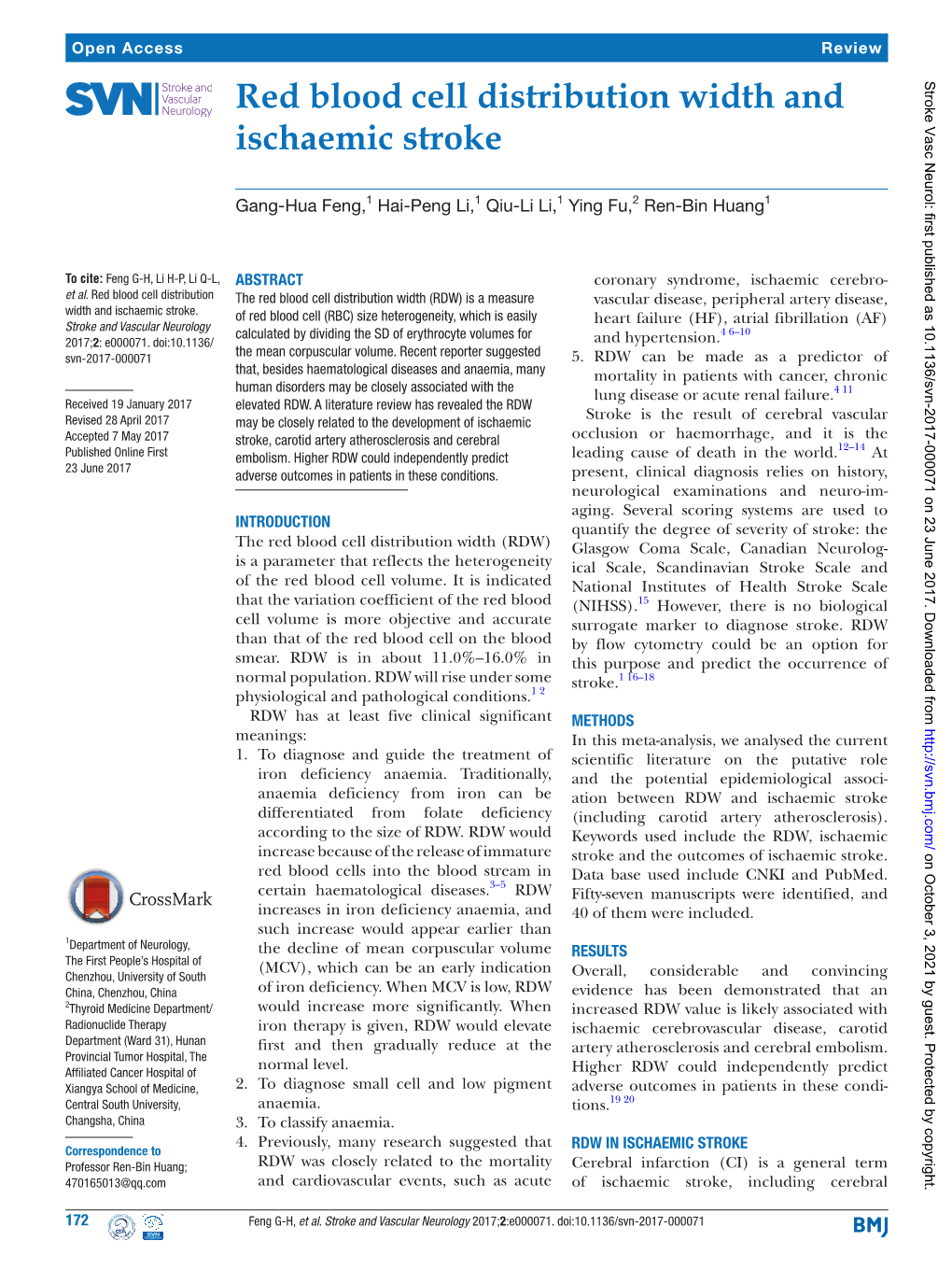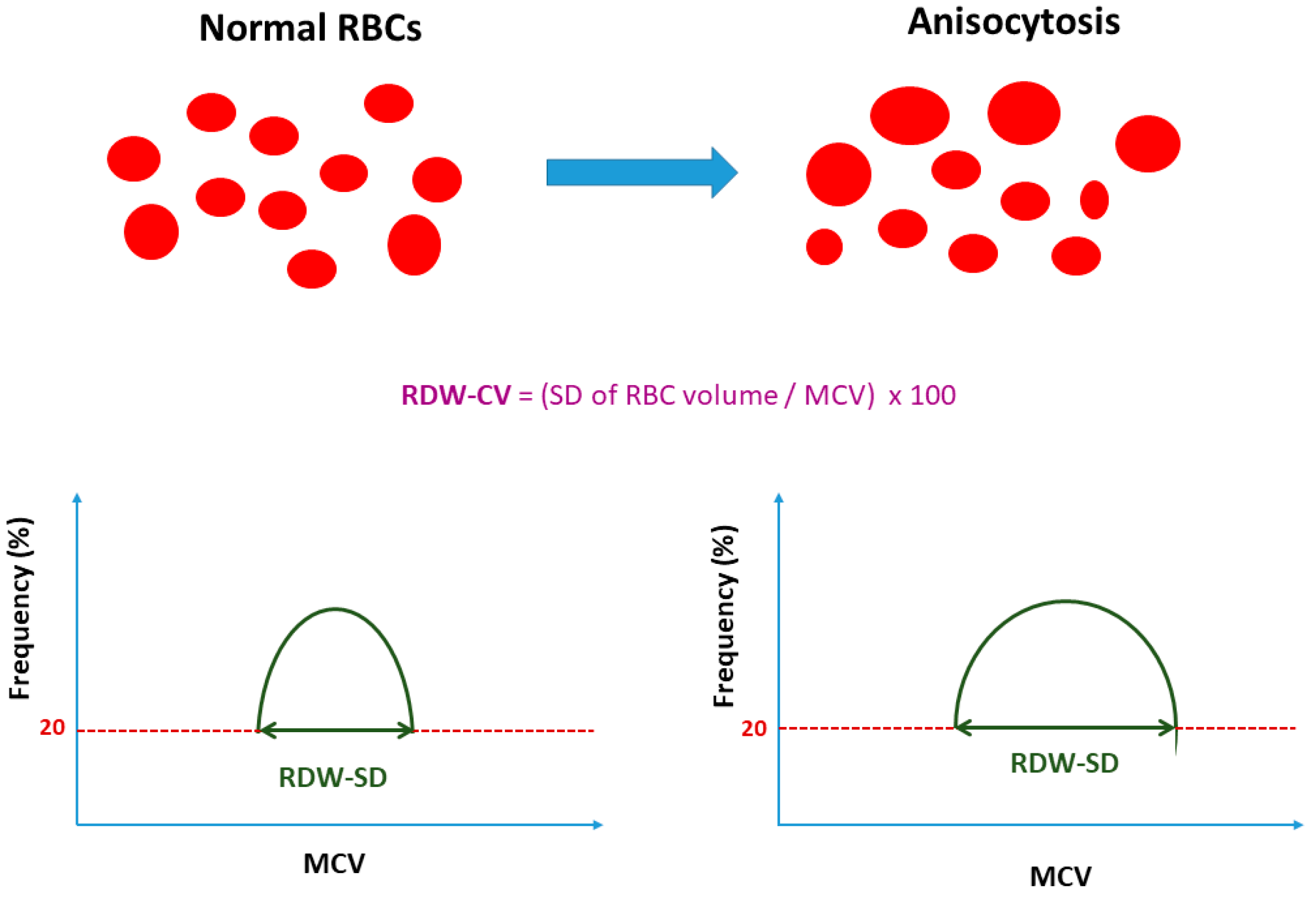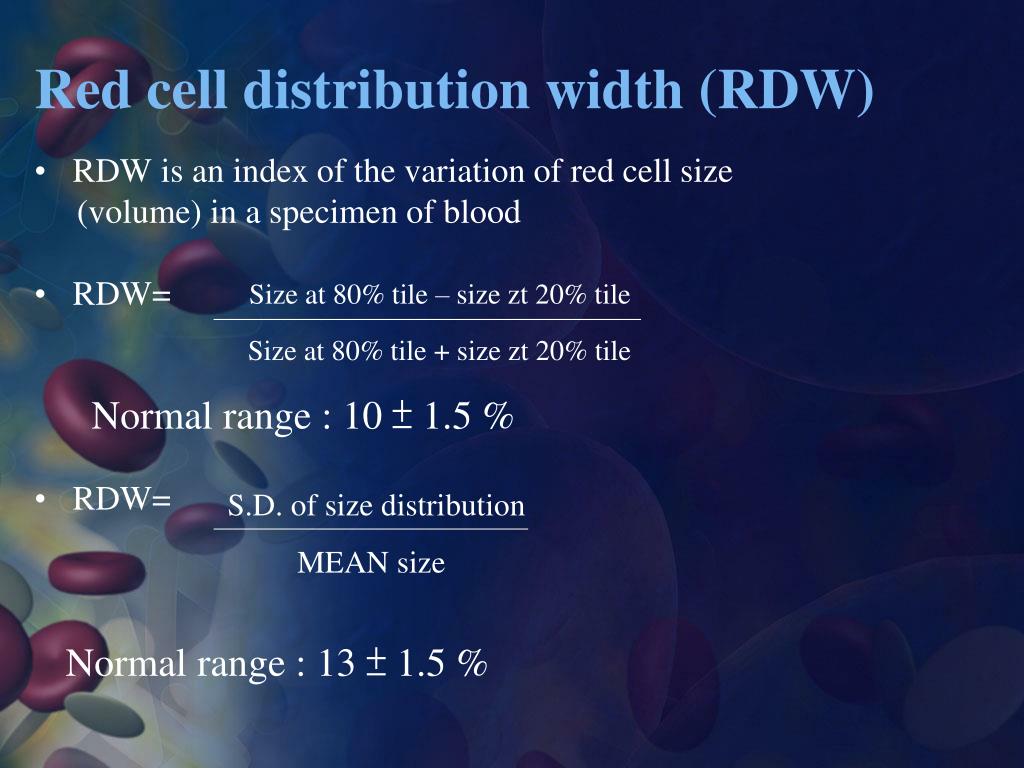
Red Blood Cell Distribution Width and Ischaemic Stroke DocsLib
1 Introduction. Red blood cell distribution width (RDW) is a numerical measure of the variability in the size of circulating erythrocytes. Therefore, higher RDW values reflect greater heterogeneity in red blood cell size (anisocytosis), which is usually caused by perturbations in erythrocyte maturation or degradation. RDW has been reported as a coefficient of variation (percentage) of red.

Clinical characteristics of different red blood cell distribution width... Download Scientific
Red blood cell distribution width ( RDW ), as well as various types thereof ( RDW-CV or RCDW and RDW-SD ), is a measure of the range of variation of red blood cell (RBC) volume that is reported as part of a standard complete blood count. [1] Red blood cells have an average volume of 80-100 femtoliters, but individual cell volumes vary even in.

Red blood cell distribution width (RDW) for the prediction of all‐cause... Download Scientific
Hoffmann, J. J., Nabbe, K. C. & van den Broek, N. M. Effect of age and gender on reference intervals of red blood cell distribution width (RDW) and mean red cell volume (MCV). Clin Chem Lab Med 53.

Additive prognostic value of red blood cell distribution width (RDW) in... Download Scientific
An elevated RDW usually results from increased or ineffective production of RBCs and excessive fragmentation or destruction of RBCs. 8 Thus, RDW is increased in patients with iron deficiency anemia, megaloblastic anemia, myelodysplastic syndrome, hemolytic anemia, liver failure, sickle cell disease, and blood transfusions. 9 Red blood cell distribution width together with MCV has been almost.

Red cell distribution width (RDW) relationship with haemoglobin... Download Scientific Diagram
Red blood cell distribution width (RDW) is a recently recognized potential inflammatory marker, which mirrors the variability in erythrocyte volume. Studies indicate that elevated RDW is associated with increased risk of mortality in CKD patients, while evidence regarding the impact of RDW on kidney outcome is limited.MethodsAltogether 523 patients with CKD stage 1-4 from a single center.

JCM Free FullText Red Blood Cell Distribution Width in Heart Failure Pathophysiology
Red blood cell distribution width (RDW), a measure of red blood cell size variability used in evaluating anemia, has been found to predict cardiovascular disease (CVD) morbidity and mortality. RDW increases with age, but the determinants of age-associated elevation in RDW independent of CVD and associated risk factors is limited.

Red blood cell distribution width as a biomarker for COVID19
RDW, red blood cell distribution width. OR, odds ratio. CI, confidence interval. View Large Image Figure Viewer; Download Hi-res image Download (PPT) 3.4 Association between RDW and cause-specific mortality. The 10 cause-specific deaths accounted for 89.8 % of all deaths, with cardiac arrest or ventricular arrhythmia (38.4 %) and.

Red Blood Cell Distribution Width PDF
A normal range for red cell distribution width is 12.2 to 16.1 percent in adult females and 11.8 to 14.5 percent in adult males. If you score outside this range, you could have a nutrient.

RDWCV en RDWSD "Red Cell Distribution Width" FULLY explainedDefinition, Function
An RDW (red blood cell distribution width) blood test measures how varied your red blood cells are in size and volume. Your red blood cells carry oxygen from your lungs to organs and tissues throughout your body. The oxygen fuels your body's cells so that they can produce energy. When it comes to your red blood cells, size matters.

Red blood cell distribution width (RDW) level at diagnosis of multiple... Download Scientific
The red blood cell distribution width (RDW) is a marker that describes the degree of heterogeneity of erythrocyte volume. Because it is part of the routine automated output of blood cell counters, the RDW is included in the diagnostic work-up of most hematologic diseases and is easily and inexpensively assessed.

Table 1 from Red blood cell distribution width in heart failure A narrative review Semantic
Red cell distribution width (RDW) 1, a measure of anisocytosis, reflects the heterogeneity of the volumes of the red blood cells (RBC).RDW is often used clinically as a part of the diagnostic work.

Common Laboratory Tests презентация онлайн
The red blood cell distribution width (RDW) is a rather simple measure of red blood cell (RBC) size heterogeneity (i.e., anisocytosis), which is easily calculated by dividing the standard deviation (SD) of erythrocyte volumes for the mean corpuscular volume (MCV). Emerging evidence suggests that, besides RBC abnormalities, many human disorders.

Red Blood Cell Distribution Width Easy Explaination YouTube
2. Materials and Methods. We conducted a systematic literature search for articles published in PubMed, Web of Science, and Scopus, between inception and the 15 April 2022, using the following terms (and their combination): "RDW" or "red blood cell distribution width" and "COPD" or "chronic obstructive pulmonary disease" or "AECOPD" or "acute exacerbation chronic.

RDWCV en RDWSD "Red Cell Distribution Width" FULLY explainedDefinition, Function
Red blood cell distribution width. De red blood cell distribution width (RDW of RCDW) is een maat voor de variatie in het volume van rode bloedcellen. Van nature hebben rode bloedcellen niet allemaal precies dezelfde grootte (en volume), er is een spreiding in de grootte. Bij bepaalde aandoeningen kan deze spreiding groter worden.

(PDF) Red Blood Cell Distribution Width/Hemoglobin Ratio DOKUMEN.TIPS
Red cell distribution width (RDW) is a parameter that measures variation in red blood cell size or red blood cell volume.. Moreno-Torres V, Royuela A, Munez-Rubio E, et al. Red blood cell distribution width as prognostic factor in sepsis: A new use for a classical parameter. J Crit Care. 2022 Jun 2. 71:154069. [QxMD MEDLINE Link.

PPT Blood CELLS COUNT PowerPoint Presentation, free download ID5697169
Red Blood Cell distribution width (RDW) is a simple measure of the broadness of erythrocyte size distribution, conventionally called anisocytosis . This measure is easily, inexpensively and rapidly calculated as ratio of standard deviation (SD) of red blood cell (RBC) volume and mean corpuscular volume (MCV) [i.e., (RDW-SD)/(MCV)×100], with final result expressed as percentage ( 2 ).
- Annie Mg Schmidt Prijs 2022
- Half Marathons New York 2024
- F1 Las Vegas Tijden Training
- La Place Meerndijk 59 3454 Hp Utrecht
- Dirk Van De Broek Schiedam
- Harry Potter Und Stein Der Weisen
- Diversity Equity And Inclusion Betekenis
- Train From Amsterdam To Frankfurt Germany
- Nederland O 21 Tsjechië O21
- Series 1 Land Rover Discovery
